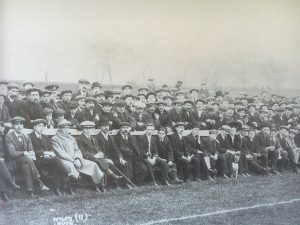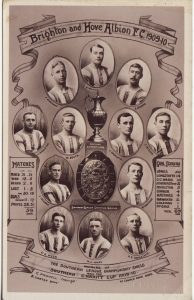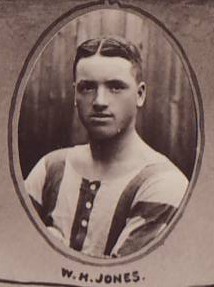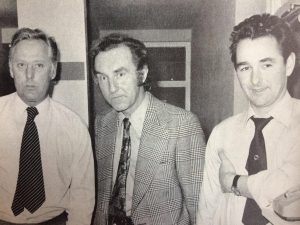‘Saturday Afternoon’ by Fred Yates 1953. To see more of the artist’s work visit https://fredyates.wordpress.com
Brighton & Hove Albion were founded in 1901 after a meeting at the Seven Stars Hotel and spent the first 19 years of their existence in the Southern League, taking the place of Brighton & Hove Rangers, before being elected to the Football League in 1920.
The club was briefly named Brighton & Hove United but this was quickly changed to ‘Albion’. In their debut season, playing at the county cricket ground in Hove they finished third in the Southern League second division behind Fulham and Grays United. Their first entry into the FA Cup saw victories over Brighton United, Eastbourne and Hastings & St Leonard’s before defeat to Clapton.
Test Match Winners
The following season Albion were runners-up to Fulham, gaining promotion to the top flight of The Southern League by winning a ‘Test Match’ (play off) against Watford.
The Goldstone Ground was formerly part of Goldstone Farm and the land was originally used for grazing cattle. Mr John Clark leased the land from the Stanford estate and offered it to amateur team Hove FC who moved in for the 1901-02 season. Clark added an 8-foot perimeter fence and turnstiles, plus a covered stand for 400 spectators and changing rooms.
The new tenants paid an annual rent of £100 plus 50% of takings over £200 and played the first game at their new home on 7 September 1901, against Clapton
In February 1902 with their cricket ground unavailable Brighton approached Hove about using the Goldstone Ground alongside their neighbours. The leaseholders agreed and Albion played their first match there on 22 February, beating Southampton Wanderers 7-1 in a friendly. By this time the Hove directors had realised that their own gate receipts would not be enough to cover the rent so Brighton’s offer of a ground share was timely and both clubs started the 1902-03 season at the ground.

Seagulls fans fill the open air bench seats
So the Goldstone became the club’s full-time home ground and they would remain there for 95 years. In 1904 Hove decided to move back to their former home, Hove Rec, leaving Brighton as sole tenants. Albion agreed a seven-year lease at £250 per year.
The club began making improvements almost immediately, erecting a new wooden stand behind the south goal. They also installed open-air bench seats next to the West Stand and added new turnstiles.

Charlie Webb, Albion legend
Charlie Webb and the ‘Champions of England’.
Albion won the Southern League 1st Division In 1909/10 and then went on to capture their first, and to date only, major trophy. The season-opening Charity Shield game was, at that time contested between the champions of the Football League and the Southern League.
Facing First Division winners Aston Villa at Stamford Bridge in front of 13,000 fans, Brighton won by the only goal, scored in the 72nd minute by Irish International inside left Charlie Webb.
On their return to Brighton after the win, fans packed the area around the train station to welcome their heroes home. The local Sussex Daily News suggested that Albion could now be dubbed ‘Champions of England’.
Charlie Webb was born at the Curragh military camp close to Dublin where his Scottish father, who was in the Black Watch, was serving. He started his football career with Bohemians and later followed in his dad’s footsteps, joining the Essex Regiment.
Posted to serve in Worthing, Webb started playing for the local team and after a trial with Rangers didn’t work out he signed for Brighton as an amateur in 1909. He went on to score 79 times in 275 appearances for the club and was picked to play for his country as both an amateur and a professional before a serious leg injury sustained at Millwall ended his playing career shortly before the First World War.
Webb joined the army, was captured and spent time in the Mainz prisoner of was camp before being repatriated and, at the end of hostilities and returning to Brighton where, still only 32, he was given the job as manager when football resumed in 1919.

A souvenir of Webb’s benefit
Awarded a benefit in 1921, Webb went on to become a major figure throughout the club’s early days keeping his role as manager until the end of the 1946-47 season )at one time turning down an approach from Spurs to become their manager) and becoming known as ‘Mr Albion’. Then, at the age of 60 and having led the club for 1,215 matches he handed over responsibility for first-team affairs to Tommy Cook, remaining with the club for two more years before his retirement.
Charlie Webb was still living locally when he passed away in 1973 at the age of 86.

Pom Pom and Bullet
In the pre-WW1 period Albion had a fine side including the likes of Bob ‘Pom Pom’ Whiting in goal and Billy ‘Bullet’ Jones up front and they also claimed the Southern Charity Cup in the same season that they won the Charity Shield.

‘Pom Pom Whiting’
‘Pom Pom’, who earned the nickname for his booming kicks, was signed from Chelsea in 1908 and was in the Albion goal up until the start of the war.
Whiting joined the Footballer’s Battalion but after finding out that his wife was pregnant and that his brother had been killed at The Somme he went AWOL. Caught in France, he was court-martialled. Sentenced to nine months hard-labour, he served just a week before being sent back to the front. Shortly after he was killed in the Battle of Arras.

‘Bullet’ Jones
William ‘Bullet’ Jones, also known as ‘The Tipton Smasher’, joined Brighton from Birmingham City in 1909. He returned to Birmingham in 1912 but a year later he was back at the Goldstone Ground where he would remain until 1947.
Like Whiting and a number of other teammates he joined the Footballer’s Battalion. Returning to the Goldstone after the war he played his final first-team match at the age of 38 in 1919. He then continued playing for the reserves before working as assistant trainer, scout and groundsman.
After his wife died in 1947, Jones retired and a year later he was found in a gas-filled room, taken to hospital and passed away.
Despite these and many other characters populating the team the club’s status as a Southern League side made it tough to keep players away from the wealthier Football League clubs.
Shooting Practice
During the 1st World War the Goldstone Ground was used as a rifle range (it was the aforementioned Charlie Webb who led rifle drills on the pitch) and there were also a number of Rugby representative matches played to raise money for the war effort. All of this left the ground and it’s surrounds in terrible condition. Supporters got together and raised £1,974 for improvements. The South Stand was rebuilt and the West Stand reseated along with remodelling of the terracing.
After the War the Football League expanded and in 1920 Brighton were admitted to the new 3rd Division. Further improvements were made throughout the 20s and in 1926 the club reached an agreement with John Clark to purchase the remainder of his lease and almost immediately negotiated a new lease with an option to buy the freehold, the option being exercised in 1930 for £5,120 16/-.

Tommy Cook
Local boy Tommy Cook joined as an amateur from Cuckfield Town and he soon showed his goalscoring ability finding the net with such regularity that he became the club’s first England international when capped for England against Wales in 1925. England won the match 2-1 but Cook was never picked again.
In 1926 Cook reported that he had been threatened by a gang of men and told to perform badly in a match against Aberdare Athletic. He responded by scoring twice.
Cook continued to be Albion’s primary source of goals throughout the remainder of the decade and he was also a regular for Sussex in the County Championship for whom he played over 450 first-class games.
When he left the Goldstone Ground for Northfleet United in 1930, Cook had scored 123 times in 209 games, a record which still stands. He would later come back to manage the club for one forgettable season and his life came to a sad end when he committed suicide in 1950 aged just 49.

Tug Wilson
1922 had seen the signing of Ernie Wilson from Midland League side Denaby United. The winger, who was known as ‘Tug’ soon won a place in the side and he would keep it for the next 14 years, making 509 league appearances and 566 in all competitions both of which are club records.
Work on the ground continued throughout the 1930s including the construction of a new North Stand. The cost of this was £1,325, paid wholly by the Supporters Club.

In 1933, whilst they were enduring another mediocre season in the 3rd Division (South) Albion managed to put together a fine FA Cup run. Victories over Crystal Palace, Wrexham, Chelsea and Bradford Park Avenue set up a 5th round tie with West Ham United. A thrilling 2-2 draw at The Goldstone saw them head to Upton Park for a replay. There sadly, the run came to an end with a narrow 1-0 defeat.
Like many stadia around the country, the Goldstone was damaged by a German bomb during the 2nd World War with the roof and girders of the North Stand suffering serious damage. The damage was repaired by the time football resumed after hostilities.
Shortly after the war the club announced a huge reconstruction programme which would affect all sides of the ground. This included increases in terracing (by 1953 all areas of the ground were terraced) and in 1954, construction of a brand new South Stand.
Record Crowd

Johnny McNichol
The early 1950s brought little in the way of success to the club. They came close to winning their way into the Second Division on a couple of occasions but never quite made it. One outstanding player was Scottish inside-forward Johnny McNichol but, as seemed to be the norm at the time he was sold as soon as a decent offer came in, moving to Chelsea where he picked up a title-winners medal in 1954-55.
1956-57 season the North Stand was extended to run the full length of the pitch and the following season the club finally escaped the Third Division (South) where they had been competing since 1920.

Dave Sexton
Fired by 20 goals from Dave Sexton they won the title and went on to spend the next four seasons in Division Two. On 27 December 1958, a record crowd of 36,747 turned up to see a clash with high-flying Fulham, which the Seagulls won 3-0.
But with their top players constantly sold off to bigger clubs it was only a matter of time before, in 1961-62, they were relegated to the 3rd Division and they then suffered another drop the following year to Division Four. They got back into the third in 1965 and spent the remainder of the 60s and all of the 70s bouncing between Divisions Two and Three.

Norman Wisdom with the team
Perhaps the club’s biggest claim during this period was the appointment of Norman Wisdom to the Board of Directors. Wisdom was a Director between 1964 and 1970, was often seen on the pitch at the Goldstone whipping up support. He also rewrote the lyrics of the club’s unofficial anthem ‘Sussex By The Sea’.

Peter Taylor, Mike Bamber and Brian Clough
Clough In – and Out
Albion dropped a bombshell in November 1973 when after relegation back to the Third Division, Chairman Mike Bamber lured Brian Clough and Peter Taylor to the club to replace Pat Saward at the helm.
Albion got plenty of publicity from the hiring but little success. During the first month of the pair’s regime the team was knocked out of the FA Cup by non-league Walton & Hersham and suffered an 8-2 home defeat to Bristol Rovers. The club narrowly avoided dropping into the Fourth tier and in the summer of 1974 Clough left for an ill-fated stint at Leeds United leaving Taylor in sole charge. He spent two years at the helm and managed to lay some foundations but it wasn’t until Alan Mullery arrived in the summer of 1976 that the club started to see an upturn in fortunes.

Mark Lawrenson tussles with Arsenal’s Alan Sunderland
Mullery’s five-year reign saw The Seagulls rise from the 3rd to the 1st Division with the arrival of Mark Lawrenson a key factor in Albion’s upturn along with the emergence of first Peter Ward and then Michael Robinson. All three were eventually sold to top teams with Lawrenson joining Liverpool where he was later joined by Robinson and Ward sold to Nottingham Forest in a deal which almost went through, was abandoned and later resurrected.
Mullery left in 1982, later joining bitter rivals Crystal Palace and next at the helm was Mike Bailey who led the club to their highest-ever League finish of 13th. But a poor start to the 1983-84 season saw Albion struggling at the foot of the table and he was relieved of his duties.

The Cup final team
Next came the colourful Jimmy Melia who failed to keep the club in the top flight but did lead them to Wembley and an FA Cup Final.
Marooned to the foot of the 1st Division, Albion’s Cup form bore no relation to their league displays. After seeing off 2nd Division Newcastle United in the 3rd Round they overcame Manchester City, champions-elect Liverpool at Anfield, Norwich City and Sheffield Wednesday to set up a final against Manchester United.

‘And Smith must score’
A 2-2 draw in the first encounter was made famous by a late chance that fell to Gordon Smith who had earlier scored, to win the game for Brighton which was saved by Gary Bailey’s legs and became known throughout football as it elicited the cry ‘And Smith must score’ from commentator Peter Jones. The replay, with an already relegated Brighton seemingly out on their feet, finished 4-0 to United and their brave attempt had failed.
After this it was back to bouncing between the second and third divisions, a spell broken by a single, 2002-2003 season in the top flight.
But in this period events away from the playing field took precedence on the south coast.

Fans demonstrate
The Sellout
A story broke in 1995 that the ground had been sold for redevelopment and it was also revealed that a clause in the club’s constitution forbidding directors from profiting if the club was wound up had been removed. Thus, Bill Archer, who had gained control of the club for £56.50 was able to remove Albion from their home of over 90 years.
Archer had arrived at the club in 1993 and ‘provided’ the £800,000 needed to save the club from a winding-up order. It was later revealed that the money had come from a bank loan using the Goldstone Ground at colllateral. When it became clear two years later that he intended to sell the ground with no provision made for a new home the fans, unsurprisingly, revolted.
A series of marches, pitch invasions and various other demonstrations failed to stop the sale and demolition going through and suddenly the club were left homeless and forced to ground-share for a number of seasons.
On 26 April 1997 Brighton played an emotional last ever home game at the Goldstone Ground, against Doncaster Rovers. They started the day three points adrift at the foot of the table and knowing anything less than a win would confirm their exit from the Football League – an exit from which there would surely be no way back.
A sell-out crowd of 11,341 filled the stadium for the 1534th and final league game at the venue. After both sides were reduced to ten men following a double sending-off, Albion finally got the breakthrough they needed when Stuart Storer scored after 67 minutes and held on for a tense, emotional 1-0 win. Results elsewhere meant that a draw at Hereford would be enough to retain their league status and Albion duly got the point needed and survived.
it is thanks to the tremendous loyalty and fighting spirit of their fans and to strong, generous new ownership from Tony Bloom that Brighton have managed not just to survive since they lost their home but also to thrive. They have done this to such an extent that having been on the verge of being forced into non-league football at the same time as they were left homeless just 20 years ago Brighton & Hove Albion now have not only a superb new stadium but a fine Premier League team capable of doing it justice.

